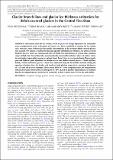Glacier branch lines and glacier ice thickness estimation for debris-covered glaciers in the Central Tien Shan
Abstract
Information about the ice volume stored in glaciers is of high importance for sustainable water management in many arid regions of Central Asia. Several methods to estimate the ice volume exist. However, none of them take the specific characteristics of flat terminus debris-covered glaciers into account. We present a method for deriving spatially-distributed ice thickness for debris-covered dendritic glaciers, which are common not only in Central Tien Shan but also in several other mountain ranges in High Asia. The method relies on automatically generated branch lines, observed surface velocities and surface topographic parameters as basic input. Branch lines were generated using Thiessen polygons and Dijkstra's path algorithm. Ice thicknesses for four debris-covered glaciers - South Inylchek, Kaindy, Tomur and Koxkar glaciers - have been estimated along the branch line network solving the equation of laminar flow. For Koxkar and South Inylchek glaciers, respectively, maximum thicknesses of 250 and 380 m were estimated. These results differ by 50 m compared with GPR measurements with an uncertainty for the debris-covered parts of 40%. Based on geodetic mass balances, we estimate that the investigated glaciers lost between 6 and 28% of their volume from 1975 to the early 2000s.
Citation
Pieczonka , T , Bolch , T , Kröhnert , M , Peters , J & Liu , S 2018 , ' Glacier branch lines and glacier ice thickness estimation for debris-covered glaciers in the Central Tien Shan ' , Journal of Glaciology , vol. 64 , no. 247 , pp. 835-849 . https://doi.org/10.1017/jog.2018.75
Publication
Journal of Glaciology
Status
Peer reviewed
ISSN
0022-1430Type
Journal article
Collections
Items in the St Andrews Research Repository are protected by copyright, with all rights reserved, unless otherwise indicated.

